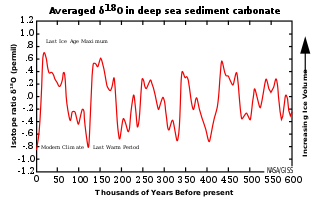James D. Hays is a professor of Earth and environmental sciences at Columbia University's Lamont-Doherty Earth Observatory. [1] Hays founded and led the CLIMAP project, which collected sea floor sediment data to study surface sea temperatures and paleoclimatological conditions 18,000 years ago. [2]

Environmental science is an interdisciplinary academic field that integrates physical, biological and information sciences to the study of the environment, and the solution of environmental problems. Environmental science emerged from the fields of natural history and medicine during the Enlightenment. Today it provides an integrated, quantitative, and interdisciplinary approach to the study of environmental systems.

Columbia University is a private Ivy League research university in Upper Manhattan, New York City. Established in 1754, Columbia is the oldest institution of higher education in New York and the fifth-oldest institution of higher learning in the United States. It is one of nine colonial colleges founded prior to the Declaration of Independence, seven of which belong to the Ivy League. It has been ranked by numerous major education publications as among the top ten universities in the world.
Hays is probably best known as a co-author of the 1976 paper in Science , [3] "Variations in the Earth's orbit: Pacemaker of the ice ages." Using ocean sediment cores, the Science paper verified the theories of Milutin Milanković that oscillations in climate can be correlated with Earth's orbital variations of eccentricity, axial tilt, and precession around the Sun (see Milankovitch cycles).

Science, also widely referred to as Science Magazine, is the peer-reviewed academic journal of the American Association for the Advancement of Science (AAAS) and one of the world's top academic journals. It was first published in 1880, is currently circulated weekly and has a subscriber base of around 130,000. Because institutional subscriptions and online access serve a larger audience, its estimated readership is 570,400 people.

Milutin Milanković was a Serbian mathematician, astronomer, climatologist, geophysicist, civil engineer and popularizer of science.
In astronomy, axial tilt, also known as obliquity, is the angle between an object's rotational axis and its orbital axis, or, equivalently, the angle between its equatorial plane and orbital plane. It differs from orbital inclination.
He graduated from Columbia University with a Ph.D. in 1964, Ohio State University with a Master of Science in 1960 and Harvard University with a Bachelor of Arts in 1956. [4] He became a recipient of the Milutin Milankovic Medal in 2010. [5]

The Ohio State University, commonly referred to as Ohio State or OSU, is a large public research university in Columbus, Ohio. Founded in 1870 as a land-grant university and the ninth university in Ohio with the Morrill Act of 1862, the university was originally known as the Ohio Agricultural and Mechanical College (Mech). The college began with a focus on training students in various agricultural and mechanical disciplines but it developed into a comprehensive university under the direction of then-Governor Rutherford B. Hayes, and in 1878 the Ohio General Assembly passed a law changing the name to "The Ohio State University". It has since grown into the third-largest university campus in the United States. Along with its main campus in Columbus, Ohio State also operates regional campuses in Lima, Mansfield, Marion, Newark, and Wooster.

Harvard University is a private Ivy League research university in Cambridge, Massachusetts, with about 6,700 undergraduate students and about 15,250 postgraduate students. Established in 1636 and named for its first benefactor, clergyman John Harvard, Harvard is the United States' oldest institution of higher learning, and its history, influence, and wealth have made it one of the world's most prestigious universities.
The Milutin Milankovitch Medal is an annual award in Earth science presented by the European Geosciences Union (EGU). The award was introduced in 1993 by the European Geophysical Society (EGS). After a merger with the European Union of Geosciences in 2003, the award has been given by the Climate: Past, Present and Future Division. The medal is awarded to scientists for outstanding research in the field of long-term climate change and modeling. It is named after the Serb geophysicist Milutin Milanković in recognition of his academic and editorial services.








